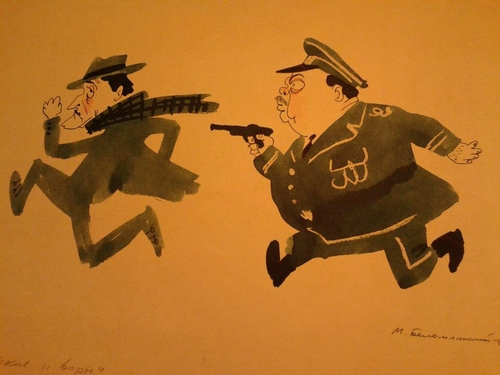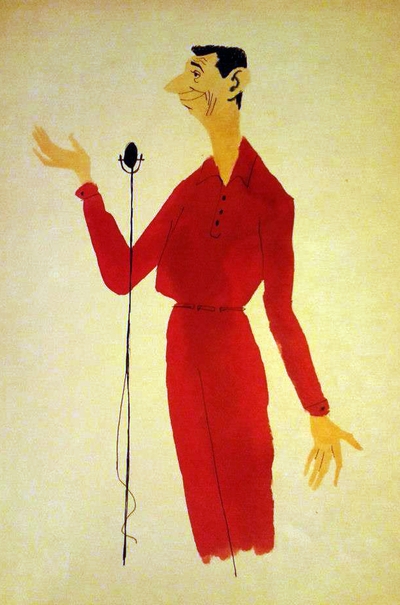Frants Gallery Space (New York) cordially invites you to attend the opening reception for
“MY DAD AND THE MOVIES”
An exhibition by Mikhail Belomlinsky
Friday,
February 13, 2015
6:30 – 10:00 PM
81 Wooster Street, 4th Floor
New York, NY 10012
RSVP +1 917 202 3782
or e-mail at rsvp@frantsgallery.com
MY DAD AND THE MOVIES
By Julia Belomlinskaya
I love the 1960s.
I was born in sixties.
To two “Sixtiers”.
Except that, at the time, my mom and dad didn’t know that they were the “Sixtiers”.
The generation of yet another Russian thaw, this time in the Soviet Russia.
The generation that will also be known as “Children of the 20th Congress of Communist Party”.
The Sixtiers will be emblazoned and disparaged.
They will be the subject of heated arguments.
Bulat Okudzhava, who sided with the Sixtiers, will write a poem
about the Sixtiers who should dethrone the Mustached Man (Stalin).
The poem ends with the Sixtiers placing their bet on the motherland
that will certainly forget about them in all the bustle,
but then again they have but one motherland…
I like this poem.
I like my young and beautiful mom and dad.
I like the year when I was born -1960.
Gagarin journeyed into outer space soon after.
And for some reason the whole world rejoices at that.
There was some kind of a worldwide jubilation.
And there already were such notions as the worldwide jubilation.
Things came into being that were universal almost for everybody.
For the first time in the 1960s.
The sixties started in 1956
after the “Hungarian Events”,
and ended in 1968
with the “Czech Events”
The cheerful, hopeful sixties spread in between two such sad events.
Miracles were happening in those years.
The first miracle, even before the manned space flight,
was the collapse of our Russian iron curtain.
First it developed tears.
And those tears became the way into the Soviet Russia
for all kinds of interesting people, things and phenomena…
Cinema, for one.
Prior to that, any foreign movie about life abroad
was called a “trophy film”.
That’s what, in fact, was written on them: “This film was taken as a trophy after the Soviet Army
had defeated the German Nazi troops near Berlin in 1945″.
It is as if the trophy movies were anonymous.
It was not indicated in the opening credits who the movie’s authors were,
what actors played the parts or in what country the movie was filmed.
Each of them was credited as a uniform “foreign film”.
First “trophy films” appeared as early as in 1939.
After the partition of Poland.
But the main wave of “trophy films” took place in 1948 –
three years after the end of the war.
At the time, the future Sixtiers were still in their teen years.
Much later Joseph Brodsky elegized the trophy films for posterity in one his
Twenty Sonnets to Mary, Queen of Scots,
where he remembers how he saw Zarah Leander in one of them playing Mary Stewart
and how hard it was to get a ticket to any of those trophy films.
But then the new times came.
The Mustached Man was no more. The iron curtain started cracking.
It was punctured by the first beaks.
Those long Jewish and Italian noses…
The first robins that pecked through the iron curtain were special people.
They were either communists or socialists
or Wronged Persons.
That is to say, the Victims of Racism, Fascism and Apartheid.
We had these posters hanging around:
NO TO FASCISM, RACISM AND APARTHEID!
This was well before time of my generation.
Jews fell easily into the category of “wronged people”.
For instance, Yves Montand and his then-wife Simone Signoret.
And the mime Marcel Marceau (Marcel Mangel) – also a descendant of Polish Jews.
In addition, all the Negroes were considered to be Victims of Racism, Fascism and Apartheid.
Therefore, for instance, the first ones to come from America were Negroes who brought jazz.
In the winter of 1955-56 – the American Negro Company Everyman Opera brought Porgy and Bess by Gershwin to Moscow and Leningrad.
The same winter of 1956 was the time of the touring in the USSR by
the “Wronged Person” Yves Montand and his wife, the “Wronged Person” Simone Signoret.
Marcel Marceau lost his entire family in Auschwitz,
which made him a wronged person without the ironic quotation marks. He came to us in 1957.
Notably, his first visit was just to Leningrad. His first visit to Moscow took place in 1961.
The first non-trophy non-anonymous films that flew to out neck of the woods
were French.
The First Week of French Cinema took place
in Moscow and in Leningrad
in 1955, from October 17 to October 23.
On October 15, a delegation of French filmmakers came to the USSR from France.
Then there were Italians.
By 1956,
over there, in Italy, everybody who was not a fascist
– that is to say, approximately half a country,
was traditionally a communist.
Their fascists were not quite those of Hitler’s.
But their communists were not quite like ours either.
They were much more to the left than ours.
But they still suited us fine.
The Italian Cinema Week in St. Peter
took place from October 18 to October 25, 1956.
It was a year after the French Cinema Week.
At the time, my dad was 22
Mom was 20
I was minus 4
Well, one could say, it was almost my time.
Italian “movie people” came with the Italian Cinema Week.
So, just imagine the quantity of all the things
that got toppled over the Sixtiers’ generation
in a short period of time between 1955 and 1957.
They saw Jean Marais, Gerard Philipe, Gina Lollobrigida,
Giulietta Masina, they saw Porgy and Bess.
They saw “the road” by Fellini, they saw Marcel Marceau…
And then, in July of 1957 in Moscow
the World Festival of Youth and Students took place.
And then, in 1958, the First International Tchaikovsky was held in Moscow.
The young American pianist Van Cliburn became the competition’s winner.
And my dad drew him from life having met him at a restaurant.
And then, in 1963, Marlene Dietrich came over,
and my parents got to have a dinner with her.
And then artists came over.
Progressive artists – friends of the Soviet Union.
There was also a visit by the American socialist and antifascist Rockwell Kent.
In 1957, he became the chairman of the
National Council of American-Soviet Friendship.
The first personal exhibition of his paintings in the USSR took place in 1958.
In 1959, the book about his trip to Europe and the USSR Of Men and Mountains was published.
And then Jean Effel came over.
The French caricature artist who worked for the communist newspaper L’Humanite.
Jean Effel came to the Soviet Union 10 times. He said: “The USSR is a country that one wants not just to visit, but also to revisit”.
The Soviet playwright Isidor Shtok wrote the play The Divine Comedy
based on the pictures of Jean Effel.
It was staged at the Sergey Obraztsov Puppet Theater in 1961.
Zinovy Gerdt played Adam!
The 1960s were rolling joyfully and cheerfully.
They kept rolling… and they rolled straight into 1968.
That’s where our invasion to Czechoslovakia took place.
And all that disco got shut down to a certain extent.
Some of the former friends of the Soviet Union reviled at us.
Yves Montand, for one.
And various others as well…
The thaw was over, replaced by a cold spell.
Though I didn’t notice that at all.
I was 8 years old.
And then the 1970s came – the Era of Stagnation.
With different movies, different stories and different heroes.
Well, what can I say?
I felt good in the seventies.
Free and cheerful.
Those were the years of my childhood, girlhood and youth.
I took freedom and good cheer for granted.
But I was always a little bit envious of my parents – of their youth,
during which Russia flung open its windows and aired its premises
for the first time after years and years of stuffiness.
At that time, in the 1960s, my dad drew these pictures.
Caricature portraits of heroes of the sixties, trailblazers of the Iron Curtain:
Actors, artists, a pianist…
At that time he came up with an idea to print lithographs from those pictures
and submit them to the Artists’ Shop that had opened at 8 Nevsky Prospekt.
We brought with us to America pictures from that series,
and some of them had been left in Dad’s studio at Chernaya River.
Recently I put them all together, and now I want to show
these pictures to the public.
They carry with them the spirit of the glorious 1960s and signs of that time.
The Time of Big Draught.

